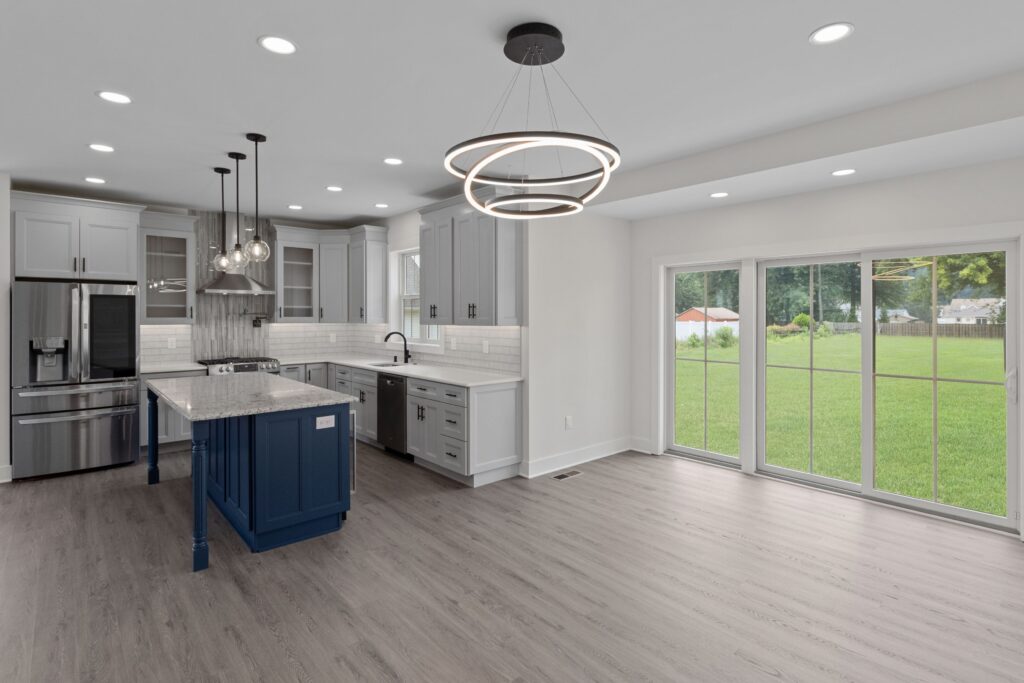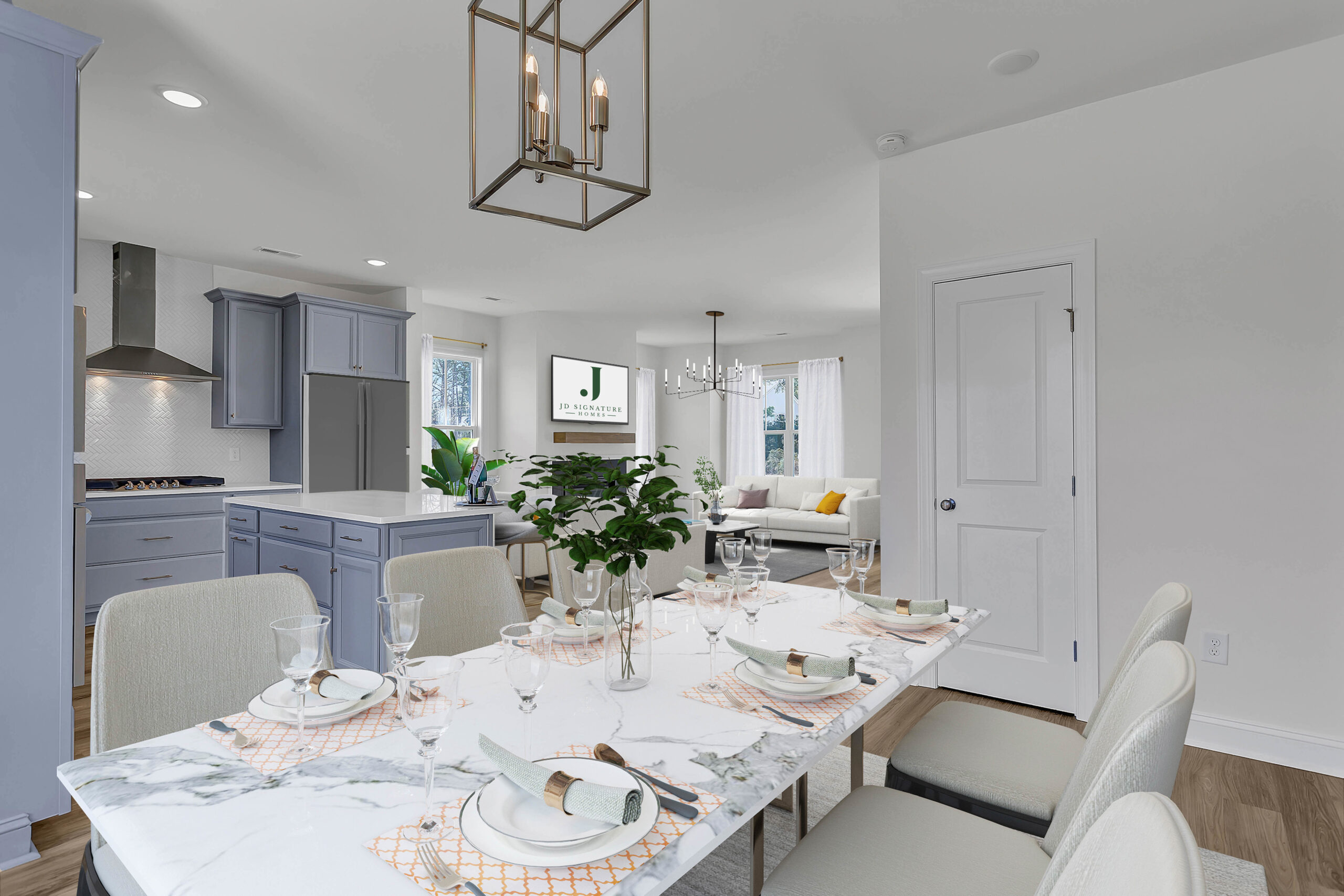Contemporary country home design seamlessly blends the warmth and charm of traditional rural aesthetics with the clean lines and minimalism of modern architecture. This fusion results in homes that are both cozy and sophisticated, offering a perfect retreat from the hustle and bustle of urban life.
Home buyers looking for livable, comfortable spaces are finding what they want in the home design trend that melds country comfort with contemporary finishes and conveniences. Many top-rated home builders are leaning into what is one of the most notable trends – the modern farmhouse – in contemporary country home design today.
1. Open Floor Plans
One of the defining features of contemporary country homes is the open floor plan. This design concept removes unnecessary walls and barriers, creating a sense of spaciousness and facilitating easier movement and communication within the home. Open floor plans often combine the kitchen, dining, and living areas into one large, cohesive space, making it ideal for family gatherings and entertaining guests.
2. Natural Materials
Natural materials are a cornerstone of contemporary country home design. Wood, stone, and metal are frequently used to create a sense of rustic authenticity while maintaining modern appeal. Reclaimed wood beams, stone fireplaces, and metal accents contribute to a warm and inviting atmosphere. The use of natural materials also aligns with the growing trend towards sustainability and eco-friendliness in home design.
3. Neutral Color Palettes
Neutral color palettes dominate contemporary country home interiors, with shades of white, beige, gray, and taupe being particularly popular. These colors create a serene and calming environment, allowing the natural beauty of the materials and the surrounding landscape to take center stage. Pops of color can be introduced through accessories, artwork, and textiles, adding personality and interest without overwhelming the space.

4. Large Windows and Natural Light
Maximizing natural light is a key aspect of contemporary country home design. Large windows, often floor-to-ceiling, are used to flood the interiors with sunlight and offer unobstructed views of the surrounding countryside. Skylights and glass doors are also common features, further enhancing the connection between the indoors and outdoors. The abundance of natural light creates a bright and airy atmosphere, making the home feel more expansive and inviting.
5. Indoor-Outdoor Living
Contemporary country homes often blur the lines between indoor and outdoor living spaces. This can be achieved through the use of sliding glass doors, expansive decks, covered patios, and outdoor kitchens. These features allow homeowners to fully enjoy their natural surroundings and create a seamless transition from the interior to the exterior. Outdoor spaces are designed to be an extension of the home, providing additional areas for relaxation and entertainment.
6. Minimalist Decor
While traditional country homes are known for their cozy, cluttered interiors, contemporary country homes favor a more minimalist approach. The focus is on quality over quantity, with carefully selected furniture and decor items that enhance the overall aesthetic without overcrowding the space. Clean lines, simple silhouettes, and a restrained color palette create a sense of order and tranquility. This minimalist approach also makes it easier to maintain a tidy and organized home.
7. Sustainable and Eco-Friendly Design
Sustainability is a growing concern for many homeowners, and contemporary country home design reflects this trend. Energy-efficient appliances, solar panels, and eco-friendly building materials are becoming increasingly popular. Green roofs, rainwater harvesting systems, and geothermal heating are also being incorporated into these homes to reduce their environmental impact. The use of sustainable design practices not only benefits the environment but also results in healthier and more cost-effective living spaces.
8. Modern Farmhouse Elements
The modern farmhouse style is a popular subset of contemporary country home design. This trend combines the rustic charm of a traditional farmhouse with the sleek lines and modern amenities of contemporary design. Key elements include barn doors, shiplap walls, and apron-front sinks. Exposed beams and wide plank flooring add to the farmhouse aesthetic, while modern lighting fixtures and streamlined furniture keep the look fresh and current.
9. Smart Home Technology
Incorporating smart home technology is another trend in contemporary country home design. Homeowners can control lighting, temperature, security, and entertainment systems with the touch of a button or through voice commands. Smart home technology enhances convenience, security, and energy efficiency, making it an attractive feature for modern country homes. Integration of technology can be done discreetly, maintaining the aesthetic integrity of the home while providing advanced functionality.
10. Personalized Spaces
Finally, contemporary country home design places a strong emphasis on creating personalized spaces that reflect the homeowner’s tastes and lifestyle. Whether it’s a cozy reading nook, a custom-built home office, or a hobby room, these personalized spaces add character and functionality to the home. The goal is to create a living environment that is not only beautiful but also uniquely suited to the needs and preferences of the residents.
Make your next home “Contemporary Country”
Contemporary country home design is all about balance. It marries the charm and warmth of traditional country living with the clean lines and functionality of modern design. By incorporating elements such as open floor plans, natural materials, neutral color palettes, large windows, and sustainable practices, these homes offer a perfect blend of comfort, style, and eco-friendliness. Whether you’re building a new home or renovating an existing one, embracing these trends can help you create a contemporary country home that is both timeless and on-trend.



